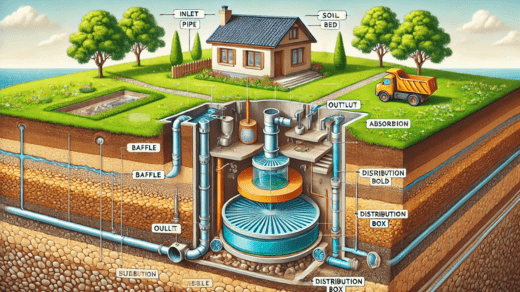Selecting the correct septic system design is essential to ensure that your property efficiently manages wastewater. A well-planned septic tank design aligns with the specific needs of your household and property conditions, offering reliable performance for decades. This article provides a comprehensive look into the key considerations that influence septic system design, helping homeowners make the best choice for their property.
Assessing Your Property’s Characteristics
Every property has unique features that will dictate which septic system design will work best. A thorough evaluation of site conditions and terrain is essential to avoid costly repairs and ensure smooth operation.
- Soil Type: Septic systems rely on soil to absorb and filter wastewater. Properties with sandy or loamy soil are ideal for conventional systems, while those with clay-heavy soil require more advanced systems.
- Topography: If your property is on uneven or sloped terrain, you may need a pressure distribution system or a pump to move wastewater uphill.
Performing a percolation test will help determine how well the soil absorbs water, guiding your decision on the best septic tank design.
Determining Water Usage and Household Size
Household size is a significant factor in choosing a septic system design. The more occupants in a home, the higher the wastewater production, requiring a larger tank and properly sized drain field.
- 1,000-gallon tanks: Suitable for homes with 1–3 people.
- 1,250 to 1,500-gallon tanks: Necessary for larger families or homes with multiple bathrooms.
Your septic tank design must accommodate your household’s water consumption, including usage from toilets, showers, washing machines, and dishwashers. A system that is too small will need frequent pumping and may experience overflows or backups.
Choosing the Right Septic System Design
There are several types of septic system designs, each with unique benefits and limitations. Understanding these options will help you make an informed choice.
- Gravity Systems: Simple and cost-effective, these systems use gravity to move wastewater from the house to the drain field. Ideal for properties with good soil drainage and level ground.
- Aerobic Treatment Units (ATUs): These systems introduce oxygen to accelerate the breakdown of waste, making them effective for properties with poor soil drainage or strict environmental regulations.
- Mound Systems: Suitable for areas with high water tables, these systems elevate the drain field above ground to prevent groundwater contamination.
- Chamber Systems: A modern alternative to traditional drain fields, chamber systems are flexible and effective in various soil conditions.
Selecting the appropriate septic tank design ensures that your system operates efficiently and complies with environmental standards.
Local Regulations and Permitting Requirements
Before installing a septic system, it is essential to understand your local government’s regulations. Some regions require specific system designs to protect groundwater and public health. Environmental concerns, such as proximity to water sources, may also influence the type of system you can install.
Obtaining permits and passing inspections are mandatory steps in the installation process. A professional contractor will be familiar with these requirements, ensuring your septic system design complies with local rules and standards.
Maintenance and Long-Term Considerations
Different septic system designs come with varying maintenance needs. Conventional gravity systems are relatively low-maintenance, with pumping required every three to five years. More complex systems, such as aerobic units, need regular inspections and servicing to keep components functioning properly.
Proper maintenance extends the lifespan of your septic system, preventing costly repairs. Neglecting maintenance can lead to backups, leaks, or complete system failure, all of which are expensive to resolve.
Evaluating Installation Costs and Budget
Septic system installation involves several cost factors, including excavation, labor, materials, and permits. Gravity-fed systems are generally more affordable to install, while advanced systems, such as ATUs and mound systems, come with higher costs due to additional components and labor.
It’s essential to plan for both the initial installation and long-term expenses. While advanced designs may have higher upfront costs, they often provide better performance in challenging site conditions, reducing the need for frequent repairs.
Planning for Future Expansion
If you anticipate future changes, such as building an extension or adding more bathrooms, it’s wise to choose a septic system design that allows for expansion. Installing a larger tank and designing a scalable drain field during initial construction can save you from expensive upgrades down the road. A system that can handle future growth ensures long-term reliability and reduces the need for costly replacements.
Working with Professional Installers
Partnering with a licensed contractor is essential for selecting the right septic tank design and ensuring proper installation. An experienced professional will conduct soil tests, recommend suitable designs, and manage the permitting process. They will also ensure the system meets local regulations and passes all inspections.
Hiring a qualified contractor minimizes the risk of installation errors and ensures your septic system will function efficiently for years to come. Professional advice is especially valuable if your property has challenging site conditions, such as poor soil drainage or sloped terrain.
Conclusion
Choosing the right septic system design for your property involves evaluating site conditions, household size, water usage, and local regulations. Each design option, from conventional gravity-fed systems to advanced aerobic units, offers specific benefits suited to different properties. Proper planning ensures your septic tank design meets your needs, functions efficiently, and complies with environmental standards.
By working with a professional installer and budgeting for both installation and maintenance, you can avoid costly repairs and ensure your septic system operates smoothly for years. Thoughtful decisions made today will protect your investment and keep your property’s wastewater management system running reliably into the future.

